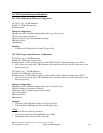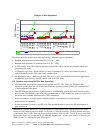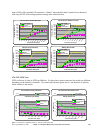
2. Vary on any Network Server Description (NWSD) with a Network server connection type of *ISCSI.
During the iSCSI network server vary on processing the QFPHIS subsystem is automatically started if
necessary. The subsystem will activate the private memory pool. iSCSI network server descriptions that
are varied on will then utilize the first private memory pool configured with at least the minimum (4MB)
size for virtual disk I/O operations.
The private memory pool is used by the server as long as the subsystem remains active. If the QFPHIS
subsystem is ended prematurely (while an iSCSI network server is active), the server will continue to
function properly but future virtual disk I/O operations will revert to the *BASE memory pool until the
system memory pool is once again allocated.
NOTE: When ending the QFPHIS subsystem, i5/OS can reallocate the memory pool, possibly assigning
the same identifier to another subsystem! Any active iSCSI network servers that are varied on and using
the memory pool at the time the subsystem is ended may adversely impact other applications either when
the memory pool reverts to *BASE or when the memory pool identifier is reassigned to another
subsystem! To prevent unexpected impacts – do not end the QFPHIS subsystem while iSCSI servers are
active.
17.2.4 Virtual Ethernet Connections:
The virtual Ethernet connections utilize the System i systems licensed internal code tasks during
operation. When a virtual Ethernet port is used to communicate between Integrated servers, or between
servers across i5/OS partitions, the host server CPU is used during the transfer. The amount of CPU used
is primarily a function of the number of transactions and their size.
There are three forms of Virtual Ethernet connections used with the IXS/IXA and iSCSI attached servers:
y The “Point to point virtual Ethernet” is primarily used for the controlling partition to communicate
with the integrated server. This network is called point to point because it has only two endpoints, the
integrated server and the i5/OS platform. It is emulated within the host platform and no additional
physical network adapters or cables are used. In host models, it is configured as an Ethernet line
description with Port Number value *VRTETHPTP.
y A “Port-based”
10
virtual Ethernet connection allows IXS, IXA or iSCSI attached servers to
communicate together over a virtual Ethernet (typically used for clustered IXS configurations), or to
join an inter-LPAR virtual Ethernet available on non-POWER5 based systems This type of virtual
Ethernet uses “network numbers”, and integrated servers can participate by configuring a port number
value in the range *VRTETH0 through *VRTETH9.
“Port-based” virtual Ethernet communications also require the host CPU to switch the
communications data between guest servers.
y A “VLAN-based” (noted as Phyp in charts) virtual Ethernet connection allows IXS, IXA and iSCSI
attached servers to participate in inter-LPAR virtual Ethernets. Each participating integrated server
needs an Ethernet line description that associates a port value such as *VRTETH0 with a virtual
adapter having a virtual LAN ID. You create the virtual adapter via the Hardware Management
Console (HMC).
VLAN-based communications also use the System i CPU to switch the communications data between
server.
17.2.5 IXS/IXA IOP Resource:
IBM i 6.1 Performance Capabilities Reference - January/April/October 2008
© Copyright IBM Corp. 2008 Chapter 17 - Integrated BladeCenter and System x Performance 284
10
“Port-Based” refers to the original method of supporting VE introduced in V5R2 for models earlier than System
i5. It is still available for integrated servers to communicate within a single partition on System i models.


















